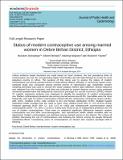Status of modern contraceptive use among married women in Debre Birhan District, Ethiopia
View/
Publication Date
10/31/2014Type
Article, Journalviews
downloads
Metadata
Show full item recordCitation
Muluken Dessalegn, et al. "Status of modern contraceptive use among married women in Debre Birhan District, Ethiopia." Journal of Public Health and Epidemiology 6.10 (2014): 316-326
Abstract/
Unless evidence based decisions are made based on local contexts, the low prevalence level of contraceptive use and the corresponding higher total fertility rate will make Ethiopia to remain the most populous country in Africa. The purpose of this study was to assess the status of modern contraceptive use among married women in Debre Birhan district, Ethiopia. A community based cross-sectional study was conducted among married women of reproductive age. Systematic random sampling technique was used to choose 851 study subjects. Before data collection, ethical clearance was obtained from the institution, and data was collected by trained diploma nurses using pretested structured questionnaire and analyzed by statistical package for social sciences (SPSS), version 20. Logistic regression analysis was employed to identify the predictors of modern contraceptive use. Modern contraceptive prevalence rate among married women was 46.9%. Injectables were the most frequently used type of modern contraceptive method (62.9%), followed by intrauterine device (16.8%), pills (14%), norplant (4.3%), male condom (1.2%) and female sterilization (0.8%). Multiple logistic regression model revealed that the need to have more children [AOR 95% CI: 9.27 (5.43 to 15.84)], husband approval [AOR 95% CI: 2.82 (1.67 to 4.80)] and husband-wife communication about contraceptives [AOR 7.32, 95% CI (3.60 to 14.86)] were found to be an independent predictors for the use of modern contraceptives. There were no statistical significant differences between modern contraceptive use and other socio-demographic and reproductive health related variables after an adjustment. Modern contraceptive use declined among married women in the district. The culture of publicly discussing the use of contraceptives and breaking the silence among the people demands substantial efforts. Considering users of contraceptives as deviant also requires paradigm shift in thinking.
Further Details
Author(s) agree that this article remain permanently open access under the terms of the Creative Commons Attribution License 4.0 International License
Publisher
Academic JournalsISSN
2141-2316Collections
- General - GEN [367]

